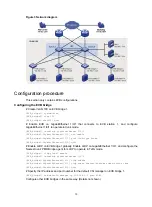
1
Configuring EVB
Overview
Edge Virtual Bridging (EVB) allows virtual machines (VMs) on a physical server to obtain bridge relay
services through a common bridge port. It enables coordinated configuration and management of
bridge services for VMs.
Data center virtualization includes network virtualization, storage virtualization, and server
virtualization. Server virtualization uses specific virtualization software such as VMware to create
VMs on a single physical server. Each VM operates independently and has its own operating system,
applications, and virtual hardware environments, as shown in
.
Figure 1 Server virtualization
VMs on a physical server communicate with each other or with the outside network through a Virtual
Ethernet Bridge (VEB). VEBs are implemented through software or hardware such as NICs. Both
implementation methods have the following limitations:
•
Lack of traffic monitoring capabilities such as packets statistics, traffic mirroring, and
NetStream.
•
Lack of network policy enforcement capabilities, such as QoS.
•
Lack of management scalability, especially in unified deployment of the internal server network
and the external network.
EVB solves these limitations. It uses a physical switch (called EVB bridge) to switch traffic for VMs on
a directly connected physical server (called EVB station). EVB implements traffic policing, network
policy enforcement, and unified network deployment and management for VMs.









































